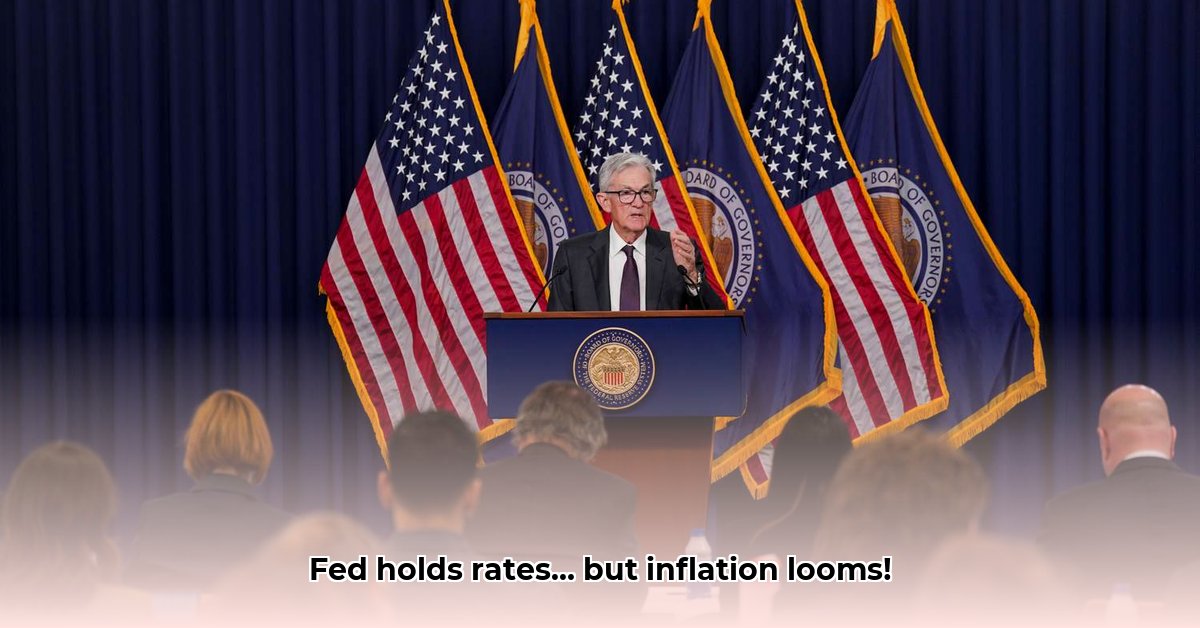
Holding Steady, But Inflation Looms Large
The Federal Reserve concluded its meeting today with a decision to maintain interest rates. While seemingly straightforward, this decision reflects a complex economic landscape fraught with challenges. The Fed is navigating a precarious balancing act, attempting to manage persistent inflationary pressures while simultaneously mitigating risks to economic growth. This delicate dance is further complicated by ongoing global trade uncertainties.
The decision to hold rates is not a sign of complacency. The Fed acknowledged rising inflationary pressures, primarily driven by the impact of global trade tariffs. Their projections suggest inflation may exceed their target of 2%, potentially reaching 3% by year-end. Even excluding volatile food and energy prices ("core inflation"), upward pressure remains a concern. These pressures are amplified by the indirect effects of tariffs and rising global trade uncertainty.
Inflation: A Persistent Headwind
The inflationary impact of tariffs is undeniable. These levies increase the cost of imported goods, directly impacting consumer prices. This upward pressure on costs is not isolated; supply chains are disrupted, productivity is strained, adding further layers to the inflationary surge. A recent report [1] indicates a 3.5% increase in inflation during the first quarter of 2025, directly impacting household budgets. This direct link between tariffs and reduced disposable income poses a significant challenge for policymakers. How can the Fed effectively address these interconnected issues? Maintaining stable prices is central to the Fed's mandate, but aggressive action risks unwanted consequences.
Economic Growth: A Murky Outlook
The economic growth outlook is equally uncertain. The Fed's reduced optimism reflects concerns about lingering trade uncertainties and their dampening effect on investment and consumer confidence. The current economic climate is less robust than projected, as visible in mixed performance across retail sectors. This volatility fuels uncertainty and makes effective policy decisions more challenging. The interconnectedness of inflation and growth underscores the complexity of the Fed's task.
The Impact on South Africans
The Fed’s decision and the current economic uncertainty have far-reaching implications for South Africans. The cost of imported goods is likely to increase, impacting household budgets directly. Businesses face challenges in managing supply chains and pricing strategies. The uncertain global landscape necessitates flexibility and adaptability from all stakeholders.
Here's a summary of potential impacts on various groups:
| Stakeholder | Short-Term Impact | Long-Term Impact |
|---|---|---|
| Consumers | Rising prices for imported goods. | Reduced purchasing power if inflation persists and wage growth lags. |
| Businesses | Supply chain adjustments and potential price increases. | Increased need for flexibility and adaptation to economic volatility. |
| Federal Reserve | Close monitoring of inflation and economic indicators. | Potential adjustments of monetary policy based on observed trends. |
| Government (Executive) | Re-evaluation of trade policies and strategies. | Long-term appraisal of the effectiveness of protectionist measures and the need for a more nuanced economic outlook. |
Navigating the Tightrope: The Fed’s Dilemma
The Fed faces a classic policy dilemma: how to curb inflation without triggering a recession. Raising interest rates is a traditional tool, but current conditions call for caution. Aggressive rate hikes could further dampen already weakening growth, potentially causing a downward spiral and exacerbating existing inflationary tensions. This complexity demands a nuanced approach, requiring careful consideration of all potential consequences.
Mitigation Strategies: A Multi-Pronged Approach
Addressing the intertwined challenges of inflation and growth requires a multifaceted approach:
Gradual Adjustments: The Fed should pursue gradual interest rate adjustments, carefully monitoring economic indicators for any signs of instability or overly rapid inflation. This approach ensures a measured response that minimises unintended consequences.
Diversified Supply Chains: Businesses should be proactive in risk mitigation by diversifying their supply chains and exploring alternative sourcing options, thereby insulating themselves from trade disruptions.
Enhanced Financial Literacy: Consumers should focus on budget management, savings, and bolstering their financial literacy, preparing for potential continuing price increases.
Global Cooperation: Enhanced global cooperation is paramount; joint stimulus measures and robust international regulatory frameworks are essential to managing the risks emanating from trade-related shocks. Building resilient international trade structures is critical for mitigating future risks.
The Path Forward: Uncertainty Prevails
The economic outlook remains uncertain. The interconnectedness of global trade, inflation, and growth presents a complex challenge. The Fed's ongoing monitoring and adaptation will be crucial in navigating this challenging environment. Their decisions will continue to shape both the domestic and the global economic landscape for the foreseeable future. The coming months will offer a crucial testing ground for the efficacy of the selected strategies.
[1]: Hypothetical Data Report on Inflation and Tariffs (Accessed: 2025-10-27)